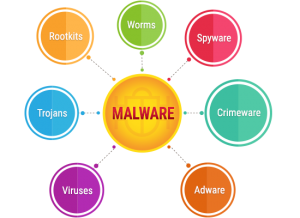What is malware?
It’s a software that’s intentionally designed to damage the computer system/ server/ client/ network. Malware is malicious software that causes damages only after it enters the target system. Malware exists in different forms like an executable code or a script or the content or some random software. Malware has an intent to act against the computer user’s interest, hence the software that causes unintentional harm is not a malware. But the programs that are officially supplied by the companies which act against the user interest is malware.
What are the different types of malware?
Listed below are some of the common types of malware attacks in recent times

Virus
A Virus is a self-replicating malware that replicates itself by inserting its code in the place of the computer code. When these replications succeed, the affected area or files are called virus-infected area/ files. The virus is always attached to an executable file. It is dormant until the user runs the file. Once this virus affects the host system, it can infect the other systems in the same network.
Ransomware
It’s a kind of malware in crypto virology where they hold hostage of victim’s data and threaten to publish it till the ransom is paid. The more advanced malware technique is called Crypto viral extortion, in which they encrypt the files making it inaccessible for the victim and demand for the ransom to be paid for decrypting those files. Decrypting these encrypted files without the key is an intractable problem to solve even for an expert. These Ransom attacks are typically carried out using Trojans. Trojans are often misrepresented as a legitimate file that the user is tricked to download or opening. Not so long ago, there was this “WannaCry worm” which spread through computers without any user interference.
Trojan
It’s a malware that mispresents itself to appear as a legit file/ software. The Trojans are considered as one of the dangerous types of malware as they look like a valid file and trick you into downloading them. The Trojans are designed for damaging, stealing or inflict some harmful action on the target system. The Trojan is a malware that requires to execute it on the device, once installed, they perform the action depending on the purpose it’s designed for. Unlike the other Malware, the Trojans do not self-replicate.
Worms
A worm is a self-replicating malware that replicates itself without user interaction. Their main aim is to automatically duplicate itself to spread into the uninfected computers, while it’s still active on the infected systems. They often target the parts of the operating system. A worm can’t be noticed unless the replication becomes uncontrollable, which consumes system resources, slowing or stopping other tasks.
Rootkit
A rootkit is a malicious computer software that attacks the target system’s hardware. This malicious software gives the attackers complete access to the user’s computer, which means there exists no privacy to the user’s data on the computer. The rootkit directly attacks the hardware of the system, therefore, giving the attackers the administrator access. Apart from this, the rootkit also masks the other malware attacks on the system, making it hard for the user to identify the attack.
Spyware
A Spyware is a malware which spies on the user’s sensitive data. The attackers use this spyware mostly to sell the user’s internet data such as banking details or passwords or any other sensitive information. They keep track of all the user’s internet activity happening on the infected system. This spyware sometimes is also used to change the settings of the device. The spyware is dangerous as they can’t be identified easily.
Adware
Adware is a malicious software that keeps popping advertisements on the screen. The adware tracks your online activities and targets you with some specific advertisements or sells these online browsing activities to some third parties. The adware develops revenue by just popping these advertisements on the screen.
Crimeware
Crimeware is a computer program designed for the sole purpose of performing malicious and illegal online activities. Although other malware is performing illegal activities, the crimeware refers to automated theft of information. The theft of information can be of any kind like redirecting the user’s web browser to another website controlled by the thief. It can also enable remote access of applications leading the thief to break into their network. It can be used to steal passwords cached on the systems. The thief can install keylogger into the systems and steal bank passwords etc.
How to take precautions from the Malware Attack?
Here are some of the preventive measures that could be taken to prevent yourself from malware attacks.
- Always keep your Operating System updated
- Always keep the windows firewall or Defender on
- Always use Antivirus
- Do not use torrents to download illegal or pirated software or files
- Do not download files or software from random websites or random sources
- Do not download patched software’s
- Do not click or download from unidentified emails or suspicious emails
How to detect the Malware presence in your laptop?
If you think you’re attacked with any of the above malware, then you’ll identify them by experiencing one of the following issues
- Misplaced folders or files in the system
- Random files created
- System running slow
- Emails sent randomly
- Freezing of the laptop
- Uploading of the personal files or data
How to remove the malware?
To remove the malware by yourself try these steps
- Try restarting the system and disconnect the system from any network connections
- Remove all temporary files and run disk clean-up
- Run virus scanner and delete the infected files
If you’re still facing issues, please contact a security expert.

